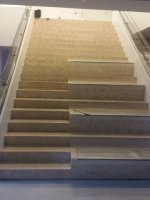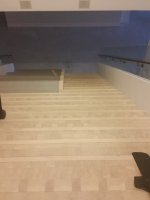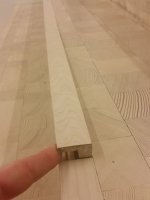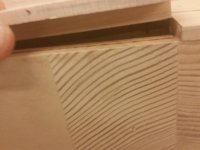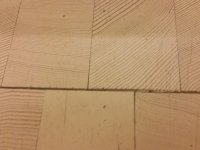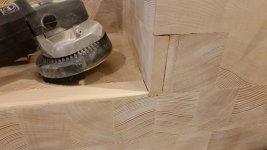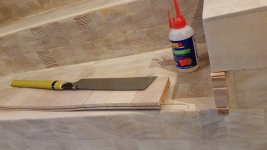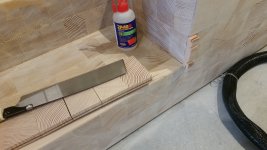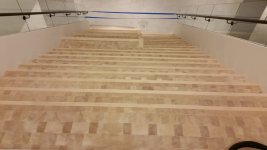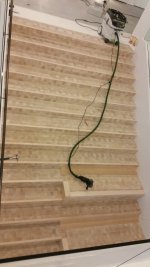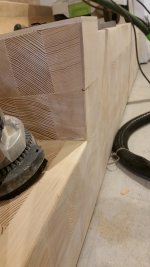ear3
Member
So I'm looking at a commission to refinish a large stairwell that connects two floors of this gallery:
View attachment 1
View attachment 2
They want to do a repair job rather than a renovation/rebuild -- fine by me, as I'll be billing hourly on this -- which essentially consists of filling and sanding everything, with some spot repairs where necessary. The RO150 and the RO90 delta pad will obviously get a good workout on this job. The stairs are covered with these end grain softwood (spruce? fir?) tiles held together with a wire running through the slot routed along the edge, and the treads are capped with a piece of dadoed maple, which in certain places has come unglued:
View attachment 3
View attachment 4
View attachment 5
In a few places the gaps between the tiles have gotten significant, though it's hard to tell whether this is due to initial poor installation or because they have been used and abused.
View attachment 6
At least part of the installation was done very poorly when they installed the maples caps at a later point (the wood tiles used to go all the way to the edge of the tread), since many of them are not sanded flush with the riser and on some of them I can still see the marks of the jigsaw (!) blade that was used to cut them to width.
In those places where the maple caps or the tiles are no longer sticking, there doesn't seem to be any degradation of the underlying structure that is causing them to come undone -- the underlying structure is concrete and therefore should be pretty stable, though I'm not sure what if any buffer/underlayment there might be between the tiles and the concrete that was used for purposes of adhesion.
So questions:
1) Best filler for use on this sort of wood floor to fill in the gaps between the tiles? It will be finished with a white wash so the initial color just has to be close, or at least not any darker than the wood tiles.
2) I'm going to have to pull up and then reglue maybe 3 or 4 of the maple caps, and perhaps one or two rows of tiles (though in my initial inspection I only saw three to four tiles that were no longer adhering). So what is the best adhesive and procedure for reattaching them, since it will be difficult to generate any type of clamping force on either the tiles or the caps. Should I go with some type of fast and strong adhesive, like 2P10, or should I use some sort of mastic with brad nails to force it down, going back later to fill the holes?
Any other thoughts or advice would also be appreciated. Thanks much
EDIT: Since the finish is very light (some sort of water-based tinted polyurethane) I don't anticipate many problems with the paper clogging up on the ROTEX. But is this perhaps a job for the Metabo LF724, or is that overkill (the tiles are 1/2" thick, but the dadoed part of the maple cap is slightly under 1/4"):
View attachment 1
View attachment 2
They want to do a repair job rather than a renovation/rebuild -- fine by me, as I'll be billing hourly on this -- which essentially consists of filling and sanding everything, with some spot repairs where necessary. The RO150 and the RO90 delta pad will obviously get a good workout on this job. The stairs are covered with these end grain softwood (spruce? fir?) tiles held together with a wire running through the slot routed along the edge, and the treads are capped with a piece of dadoed maple, which in certain places has come unglued:
View attachment 3
View attachment 4
View attachment 5
In a few places the gaps between the tiles have gotten significant, though it's hard to tell whether this is due to initial poor installation or because they have been used and abused.
View attachment 6
At least part of the installation was done very poorly when they installed the maples caps at a later point (the wood tiles used to go all the way to the edge of the tread), since many of them are not sanded flush with the riser and on some of them I can still see the marks of the jigsaw (!) blade that was used to cut them to width.
In those places where the maple caps or the tiles are no longer sticking, there doesn't seem to be any degradation of the underlying structure that is causing them to come undone -- the underlying structure is concrete and therefore should be pretty stable, though I'm not sure what if any buffer/underlayment there might be between the tiles and the concrete that was used for purposes of adhesion.
So questions:
1) Best filler for use on this sort of wood floor to fill in the gaps between the tiles? It will be finished with a white wash so the initial color just has to be close, or at least not any darker than the wood tiles.
2) I'm going to have to pull up and then reglue maybe 3 or 4 of the maple caps, and perhaps one or two rows of tiles (though in my initial inspection I only saw three to four tiles that were no longer adhering). So what is the best adhesive and procedure for reattaching them, since it will be difficult to generate any type of clamping force on either the tiles or the caps. Should I go with some type of fast and strong adhesive, like 2P10, or should I use some sort of mastic with brad nails to force it down, going back later to fill the holes?
Any other thoughts or advice would also be appreciated. Thanks much
EDIT: Since the finish is very light (some sort of water-based tinted polyurethane) I don't anticipate many problems with the paper clogging up on the ROTEX. But is this perhaps a job for the Metabo LF724, or is that overkill (the tiles are 1/2" thick, but the dadoed part of the maple cap is slightly under 1/4"):

